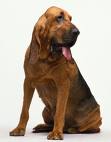
![]() The Bloodhound breed is a mellow, cheerful, affectionate, gentle, and even-tempered dog. Because of its strong tracking instinct, it can be willful, and somewhat difficult to obedience train. However, with the proper amount of time, effort, and how well you treat it,this can be achieved easily.
The Bloodhound breed is a mellow, cheerful, affectionate, gentle, and even-tempered dog. Because of its strong tracking instinct, it can be willful, and somewhat difficult to obedience train. However, with the proper amount of time, effort, and how well you treat it,this can be achieved easily.
![]() The Bloodhound is a kind, patient, noble, mild-mannered and lovable dog. Gentle, affectionate and excellent with children. This is truly a good natured companion. These dogs are so good-natured that they will lie there and meekly let children clamber all over them. This breed loves all the attention they receive from children.
The Bloodhound is a kind, patient, noble, mild-mannered and lovable dog. Gentle, affectionate and excellent with children. This is truly a good natured companion. These dogs are so good-natured that they will lie there and meekly let children clamber all over them. This breed loves all the attention they receive from children.
![]() Bloodhounds are very energetic outdoors and boisterous when young, determined and independent. It needs firm, but gentle training. This breed tends towards willfulness. The new owner of a Bloodhound will need to have plenty of patience and to possess great tact for training to succeed. Do not expect too much by way of obedience from this dog - they are naturally gentle animals but they do have minds of their own and will often make their own decisions rather than following your orders.
Bloodhounds are very energetic outdoors and boisterous when young, determined and independent. It needs firm, but gentle training. This breed tends towards willfulness. The new owner of a Bloodhound will need to have plenty of patience and to possess great tact for training to succeed. Do not expect too much by way of obedience from this dog - they are naturally gentle animals but they do have minds of their own and will often make their own decisions rather than following your orders.
![]() Bloodhounds weigh from 36 to 50 kg and stand 58 to 69 cm high where the neck and back meet. The acceptable colors for Bloodhounds are black and tan, liver and tan, or red. The coat of the Bloodhound is typical for a scenthound: hard, and composed of fur alone.
Bloodhounds weigh from 36 to 50 kg and stand 58 to 69 cm high where the neck and back meet. The acceptable colors for Bloodhounds are black and tan, liver and tan, or red. The coat of the Bloodhound is typical for a scenthound: hard, and composed of fur alone.
![]() The Bloodhound originated in Belgium/France.
The Bloodhound originated in Belgium/France.
![]() Compared to other purebred dogs, Bloodhounds have an unusually high rate of gastrointestinal ailments, with gastric dilatation volvulus (bloat) being the most common type of gastrointestinal problem.They also have an unusually high incidence of eye, skin, and ear ailments. Eyes, ears, and skin should be inspected frequently for signs of developing problems. Owners should be especially aware of the signs of GDV, which is both the most common illness and the leading cause of death of Bloodhounds.
Compared to other purebred dogs, Bloodhounds have an unusually high rate of gastrointestinal ailments, with gastric dilatation volvulus (bloat) being the most common type of gastrointestinal problem.They also have an unusually high incidence of eye, skin, and ear ailments. Eyes, ears, and skin should be inspected frequently for signs of developing problems. Owners should be especially aware of the signs of GDV, which is both the most common illness and the leading cause of death of Bloodhounds.
![]() Bloodhounds are bred for the specific purpose of tracking human beings. Consequently, it is often used by authorities to track escaped prisoners or missing persons
Bloodhounds are bred for the specific purpose of tracking human beings. Consequently, it is often used by authorities to track escaped prisoners or missing persons